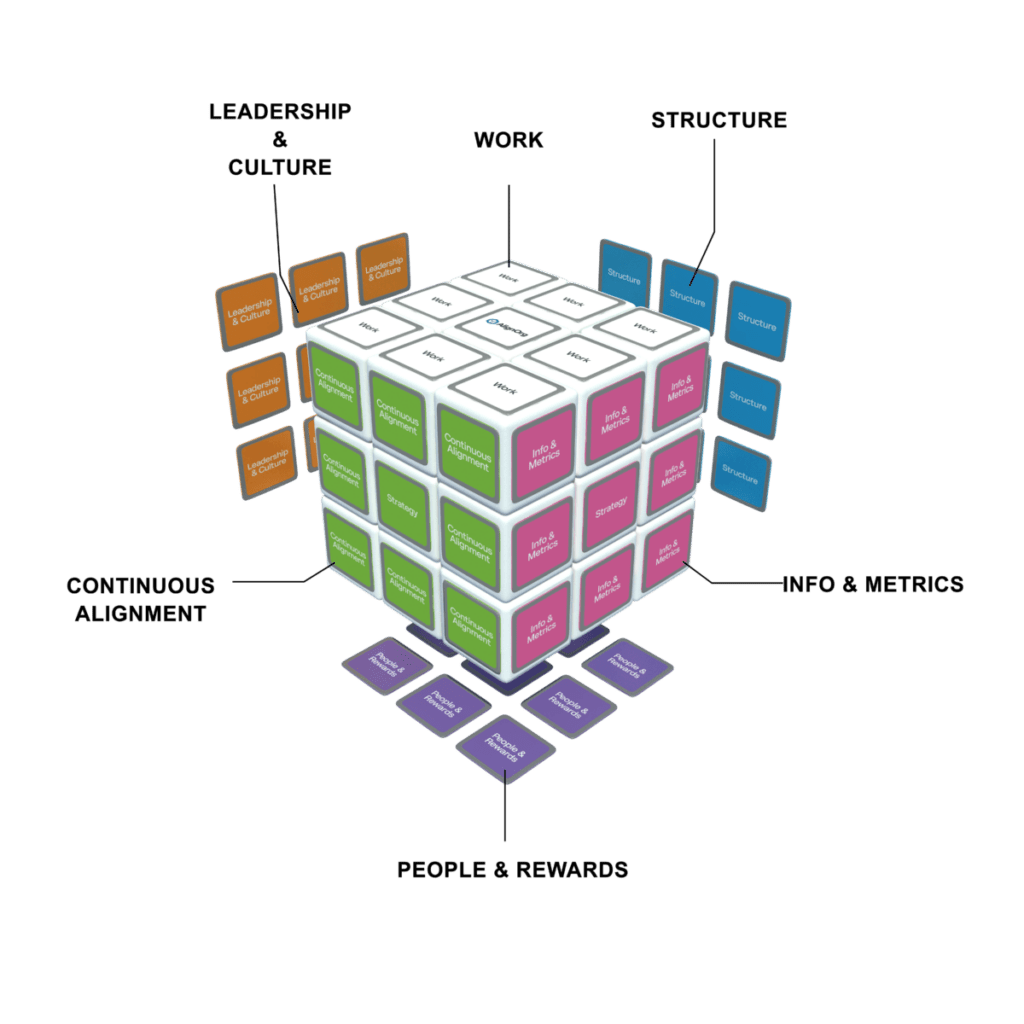Embarking on an organization redesign is no easy feat. It can take months or even years, disrupt day-to-day activities and create discomfort among the ranks. Done right, it can ensure your company stays ahead of competition. Done wrong, and you’ve wasted time and money while your organization never achieves its full potential. Let’s discuss the importance of organization alignment and explore four steps you should take to set your org up for redesign success.
Why Does Organization Alignment Matter?
Misalignment in just one area of your organization can ripple outward. It creates inefficiency and can keep your business from reaching its full potential. Think of an organization as a cube , where all six sides (work processes, people, structure, etc.) need to fit seamlessly together. A single misaligned piece impacts every other side.

By aligning all aspects of your organization to a central strategy, you position it for success and foster an environment where employees can thrive and deliver their best work.
A redesign means considerable work but can carry big rewards. Consider Dunkin’ Donuts decision several years ago to drop the word “Donuts” from its name. That might seem like a minor change, but it went far beyond the name.
Customer trends had shifted. Consumers wanted a wider variety of drink options, with fast, easy pickup. In response, Dunkin’ changed its strategy from a focus on coffee and donuts. It realigned every facet of its organization—store layouts, menus, customer interactions, marketing and internal processes—to ensure all sides of the business were working in harmony toward this new strategic direction.
The result: They attracted younger clients who want a variety of food and beverage options, easy mobile ordering and convenient service. The company survived the pandemic, saw record stock prices and was eventually purchased by Inspire Brands, which also owns chains like Sonic, Jimmy Johns and Arby’s.
The point: A good redesign isn’t a rebrand. It doesn’t mean changing just one aspect of your business. A successful redesign must be carefully planned and consider every facet of your organization. The following four steps can help you start your redesign journey off on the right foot:
Step 1. Be Clear on Objectives and Outcomes
A successful organization redesign starts with clarity. Begin by answering the fundamental question: What are we trying to achieve?
Key Points to Address:
- Identify strategic objectives (e.g., entering a new market, scaling operations, reducing costs).
- Define measurable outcomes to track success.
- Assess current organizational capabilities and identify gaps.
Being specific about desired results ensures all decisions during the redesign process align directly with your goals. Without clear objectives, teams often waste time and energy pursuing disconnected or low-impact initiatives.
Pro Tip: Set expectations for desired behaviors that align with your strategic objectives. For example, if improving operational quality is the goal, help team members understand which behaviors lead to consistent, high-quality outputs.
Step 2. Involve the Right People
A successful redesign is impossible without collaboration across diverse perspectives and expertise. You need a team of creative problem solvers who bring strategic, technical and operational knowledge to the table.
Who should you include?
- Alignment Leaders®: Senior executives who can champion the redesign, articulate its strategic goals and ensure sustained momentum.
- Change Partners: Internal or external collaborators who guide processes, provide diagnostic tools, and help align all areas of the organization.
- A Diverse Team: Representatives from varied functions and backgrounds to encourage holistic thinking and innovative solutions.
The right people should also bring soft skills such as adaptability, strong communication and a willingness to collaborate and compromise for the organization’s best interests.
Pro Tip: Leverage cross-functional teams to tackle specific areas of the redesign. Their varied perspectives can lead to more robust, innovative solutions.
Step 3. Earmark the Right Amount of Time
Redesigning an organization can be time-intensive, but you don’t have to do everything at once. Breaking the process into manageable phases or sprints helps maintain momentum while minimizing disruptions to day-to-day operations.
Phased Approach:
- Diagnosis: Pinpoint where existing misalignments are creating problems.
- Design: Outline how resources, roles and teams will operate strategically, then work out operational and tactical details in smaller groups.
- Activate: Align daily operations with the new structure and track progress.
Pro Tip: Establish realistic timeframes for each phase based on your organization’s size, complexity and readiness for change.
Step 4. Leverage Proven Approaches and Tools
When kicking off a redesign, following a structured methodology ensures consistency, direction, and measurable outcomes.
Tools and frameworks to have in your “redesign kit”
- Diagnostic tools allow you to identify gaps in organizational capabilities and provide data-driven insights for improvement.
- Design frameworks help you implement operational changes systematically, focusing on long-term benefits.
- Decision models help facilitate clear decision making and eliminate unnecessary delays and confusion, keeping all stakeholders on the same page.
Pro Tip: Use visualization tools during workshops to bring designs to life and encourage meaningful discussions.
Achieving a Successful Redesign
Redesigning an organization isn’t a one-and-done effort. It’s a cyclical process of assessment, realignment and improvement. Following these steps ensures your business doesn’t merely adapt to market conditions but thrives by maximizing its potential.
For more practical tips to help you complete a successful organization redesign, download our free Executive Guide, Kicking Off a Successful Organization Redesign.





